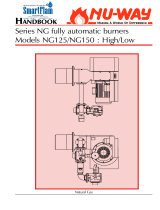Table of Contents
1.0 INTRODUCTION ...................................................................................................................................................................................................................................... 4
2.0 SAFETY GUIDELINES............................................................................................................................................................................................................................. 5
2.1 GENERAL DESCRIPTION OF SAFETY SYMBOLS USED............................................................................................................................................................ 5
2.2 WHAT TO DO IF YOU SMELL GAS ................................................................................................................................................................................................ 6
3.0 PRINCIPAL PARTS ................................................................................................................................................................................................................................. 7
4.0 TECHNICAL DATA .................................................................................................................................................................................................................................. 9
5.0 DIMENSIONS AND CLEARANCES ...................................................................................................................................................................................................... 10
5.1 DIMENSIONAL DRAWINGS .......................................................................................................................................................................................................... 10
5.2 CLEARANCES ................................................................................................................................................................................................................................ 11
6.0 GENERAL REQUIREMENTS ................................................................................................................................................................................................................ 12
6.1 RELATED DOCUMENTS ............................................................................................................................................................................................................... 12
7.0 WATER QUALITY .................................................................................................................................................................................................................................. 13
8.0 LOCATION ............................................................................................................................................................................................................................................. 13
8.1 PLANT ROOM REQUIREMENTS .................................................................................................................................................................................................. 13
8.2 GENERAL REQUIREMENTS ......................................................................................................................................................................................................... 13
8.3 CLEARANCES ................................................................................................................................................................................................................................ 14
8.4 CONDENSATE DRAIN ................................................................................................................................................................................................................... 14
9.0 GAS SUPPLY ......................................................................................................................................................................................................................................... 14
9.1 SERVICE PIPES ............................................................................................................................................................................................................................. 14
9.2 METERS.......................................................................................................................................................................................................................................... 14
9.3 GAS SUPPLY PIPES ...................................................................................................................................................................................................................... 14
9.4 BOOSTED SUPPLIES .................................................................................................................................................................................................................... 14
9.5 PLANT-ROOM CONTROL VALVE ................................................................................................................................................................................................ 14
10.0 FLUE SYSTEM ....................................................................................................................................................................................................................................... 16
10.1 FLUE SYSTEM GENERAL REQUIREMENTS .............................................................................................................................................................................. 16
10.2 FLUE SYSTEM TECHNICAL DETAILS ......................................................................................................................................................................................... 17
10.3 FLUE DISCHARGE......................................................................................................................................................................................................................... 17
10.4 CONDENSATE DRAIN ................................................................................................................................................................................................................... 17
10.5 APPROVED FLUE SYSTEM .......................................................................................................................................................................................................... 19
10.6 INSTALLATION PRECAUTIONS ................................................................................................................................................................................................... 19
10.1 ROOM SEALED (TYPE C) FLUE ASSEMBLY .............................................................................................................................................................................. 20
10.2 INSTALLATION OF FLUE TRANSITION KIT TO HCB46CE-HCB61CE BOILERS ..................................................................................................................... 20
10.3 INSTALLATION OF TRANSITION KIT TO HCB86CE BOILER .................................................................................................................................................... 22
11.0 FLUE TERMINAL INSTALLATION ....................................................................................................................................................................................................... 25
11.1 TYPE C
13
(Horizontal room sealed) ................................................................................................................................................................................................ 25
11.2 FLUE TERMINAL GUARDING ....................................................................................................................................................................................................... 26
11.4 TYPE C
33
(Vertical room sealed) .................................................................................................................................................................................................... 28
11.5 TYPE C
43
(U duct) ........................................................................................................................................................................................................................... 34
11.6 TYPE C
53
(Twin pipe) ...................................................................................................................................................................................................................... 34
11.7 TYPE B
23
(Conventional flue with fan assistance) ......................................................................................................................................................................... 39
11.8 C63 Certified Flue Systems ............................................................................................................................................................................................................ 40
12.0 AIR SUPPLY .......................................................................................................................................................................................................................................... 41
12.1 COMBUSTION VENTILATION ....................................................................................................................................................................................................... 41
12.2 COOLING VENTILATION ............................................................................................................................................................................................................... 41
13.0 WATER CONNECTIONS ....................................................................................................................................................................................................................... 42
13.1 GENERAL ....................................................................................................................................................................................................................................... 42
13.2 OPEN VENTED SYSTEM ARRANGEMENT ................................................................................................................................................................................. 42
13.3 SEALED SYSTEM ARRANGEMENT............................................................................................................................................................................................. 42
14.0 SCHEMATICS ........................................................................................................................................................................................................................................ 44
14.1 key for schematics .......................................................................................................................................................................................................................... 44
14.2 CIRCULATING PUMPS .................................................................................................................................................................................................................. 47
14.3 PRIMARY PIPEWORK HEADER SIZING ...................................................................................................................................................................................... 48
15.0 ELECTRICAL SUPPLY ......................................................................................................................................................................................................................... 49
15.2 EXTERNAL CONTROLS ................................................................................................................................................................................................................ 49
15.3 HIGH VOLTAGE CONNECTOR STRIP ......................................................................................................................................................................................... 50
15.4 LOW VOLTAGE CONNECTOR STRIP ......................................................................................................................................................................................... 50
15.5 ELECTRICAL CONNECTIONS ...................................................................................................................................................................................................... 52
15.6 FUSES ............................................................................................................................................................................................................................................. 52
15.7 ARC WELDING PRECAUTIONS ................................................................................................................................................................................................... 52
15.8 WIRING DIAGRAM ......................................................................................................................................................................................................................... 53
15.9 LADDER DIAGRAM ........................................................................................................................................................................................................................ 54
16.0 SMART SYSTEM CONTROL ................................................................................................................................................................................................................ 55
16.1 GENERAL ....................................................................................................................................................................................................................................... 55
16.2 SMART SYSTEM CONTROL PANEL ............................................................................................................................................................................................ 55
ACCESS MODES ........................................................................................................................................................................................................................... 55
16.3 SAVING PARAMETERS................................................................................................................................................................................................................. 56
16.4 STATUS DISPLAY SCREENS ....................................................................................................................................................................................................... 58
17.0 COMMISSIONING AND TESTING ........................................................................................................................................................................................................ 60
17.1 ELECTRICAL INSTALLATION ....................................................................................................................................................................................................... 60
17.2 GAS INSTALLATION ...................................................................................................................................................................................................................... 60
17.3 WATER CONNECTIONS ............................................................................................................................................................................................................... 60
17.4 COMMISSIONING THE EQUIPMENT ........................................................................................................................................................................................... 60
17.5 TEMPERATURE ADJUSTMENT PROCEDURE ........................................................................................................................................................................... 61
17.6 INSTALLATION NOISE .................................................................................................................................................................................................................. 61
18.0 LPG FUEL .............................................................................................................................................................................................................................................. 62
18.1 RELATED DOCUMENTS ............................................................................................................................................................................................................... 62
18.2 CONVERSION TO LPG .................................................................................................................................................................................................................. 62
18.3 LPG COMMISSIONING AND TESTING ........................................................................................................................................................................................ 64
19.0 MAINTENANCE ..................................................................................................................................................................................................................................... 65
19.1 GENERAL ....................................................................................................................................................................................................................................... 65
19.2 MAINTENANCE SCHEDULE ......................................................................................................................................................................................................... 65
19.3 BURNER INSPECTION .................................................................................................................................................................................................................. 65






















